Cottage garden design embodies a charming blend of flowers, herbs, and vegetables, creating a cozy and inviting atmosphere. It’s all about embracing a relaxed, informal style, where nature takes center stage, and colorful blooms spill over onto winding paths. Whether you have a small space or a larger backyard, these gardens invite creativity and personal touches, making them a delightful way to showcase your love for gardening.
Adding Whimsical Garden Decor

When it comes to cottage garden design, adding whimsical decor can make a huge difference. Imagine stepping into a space filled with vibrant colors and playful elements. This image showcases a charming garden that perfectly captures that spirit.
The front of the cottage is adorned with hanging planters and cheerful flowers, creating a warm welcome. Brightly colored birdhouses add a touch of fun, inviting feathered friends to visit. The little gnome peeking out adds a playful character, making the garden feel alive.
Pathways lined with stones lead you through this delightful space. Each step reveals new surprises, from colorful pots to unique garden ornaments. This design encourages exploration and sparks joy, making it a perfect spot for relaxation or gathering with friends.
Incorporating these whimsical touches can transform any garden into a magical retreat. Whether it’s a quirky statue or a splash of color, these elements bring personality and charm to your outdoor space.
Creating Cozy Seating Areas
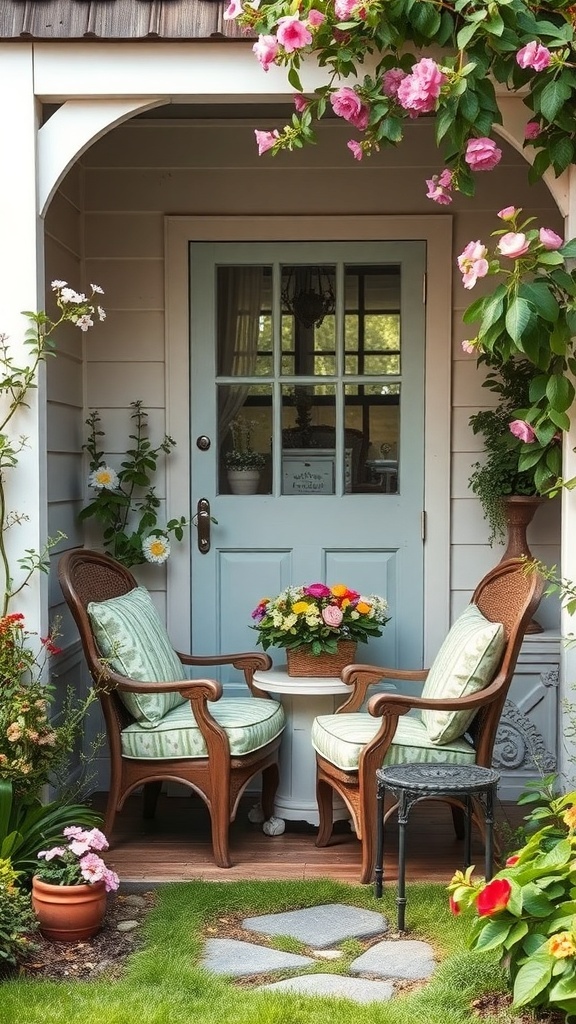
Creating a cozy seating area in your cottage garden can transform it into a welcoming retreat. Picture a charming spot with two comfortable chairs, perfect for sipping tea or enjoying a good book. The soft cushions invite you to sit back and relax.
In the image, you can see a lovely setup right by the entrance. The light blue door adds a touch of charm, while the surrounding flowers bring life and color. A small table sits between the chairs, ideal for placing a cup or a small vase of fresh blooms.
To enhance this cozy vibe, consider adding some potted plants around the seating area. They not only beautify the space but also create a sense of privacy. You can even hang some flowering vines to add height and interest.
Don’t forget about the ground! A few stepping stones leading to the seating area can make it feel more inviting. The lush green grass adds a soft touch underfoot, making it a perfect spot to unwind.
Embracing Natural Curves and Lines
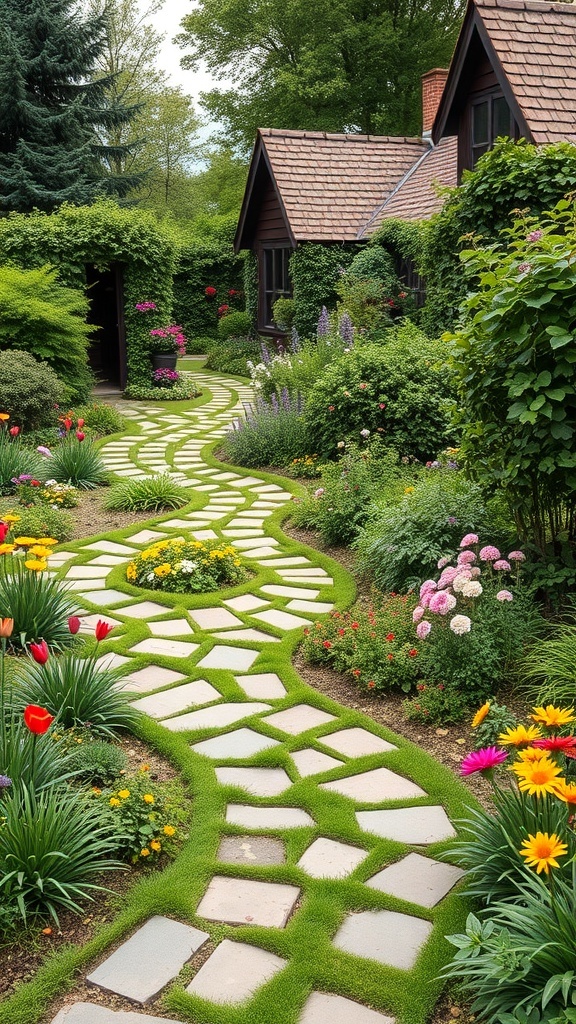
Cottage gardens are all about charm and character. The image shows a winding pathway that invites you to explore. The gentle curves of the path create a sense of flow, making the garden feel alive and welcoming.
Notice how the stones are laid out in a playful manner, breaking away from rigid lines. This approach adds a relaxed vibe, perfect for a cozy cottage setting. The lush greenery surrounding the path enhances this natural feel, making the garden a delightful retreat.
Flowers in vibrant colors peek through the greenery, adding splashes of joy. The mix of textures—from the soft grass to the sturdy stones—creates visual interest. This design encourages you to slow down and appreciate the beauty around you.
Incorporating curves in your garden design can transform a simple space into a magical one. It allows for a more organic look, blending seamlessly with nature. So, whether you’re planning a new garden or refreshing an old one, think about how you can use curves to make your space feel inviting and alive.
Choosing the Right Plant Combinations
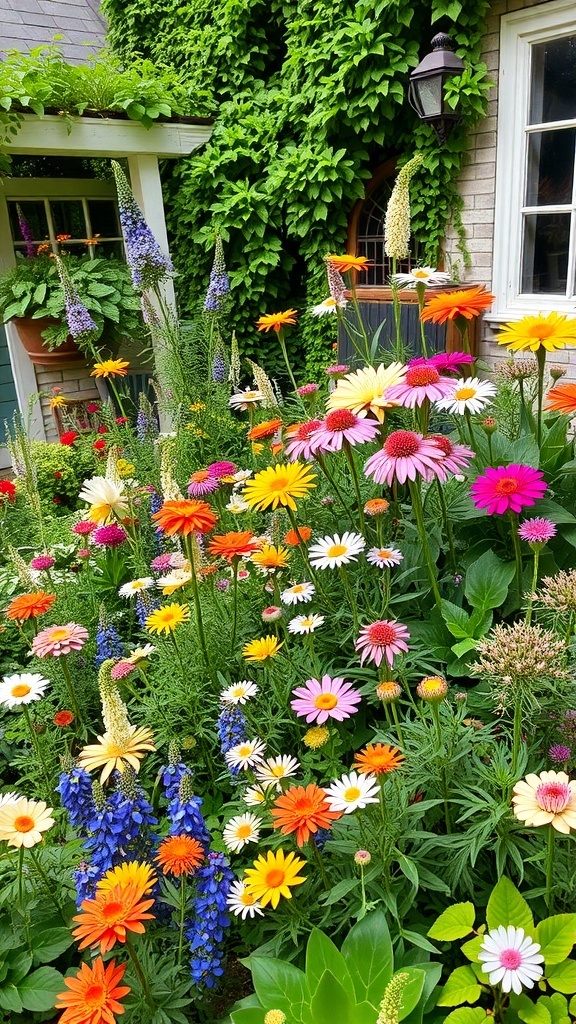
Creating a cottage garden is all about mixing colors and textures. The image shows a vibrant display of flowers, showcasing a delightful array of hues. This lively combination can inspire anyone looking to design their own garden.
When selecting plants, think about how they will look together. The bright yellows, pinks, and oranges in the image create a cheerful atmosphere. Pairing flowers like daisies and gerbera with taller plants like delphiniums adds depth and interest.
Consider the blooming seasons of your chosen plants. This ensures that your garden remains colorful throughout the year. The image features a mix of early and late bloomers, which keeps the garden lively.
Don’t forget about foliage! Green leaves provide a beautiful backdrop for flowers. The lush greenery in the image complements the colorful blooms perfectly. Mixing different leaf shapes and sizes can enhance the overall look.
Lastly, think about the sunlight and soil conditions in your garden. Some plants thrive in full sun, while others prefer shade. The variety in the image suggests a well-planned layout that caters to different needs.
Incorporating Edible Plants into the Design
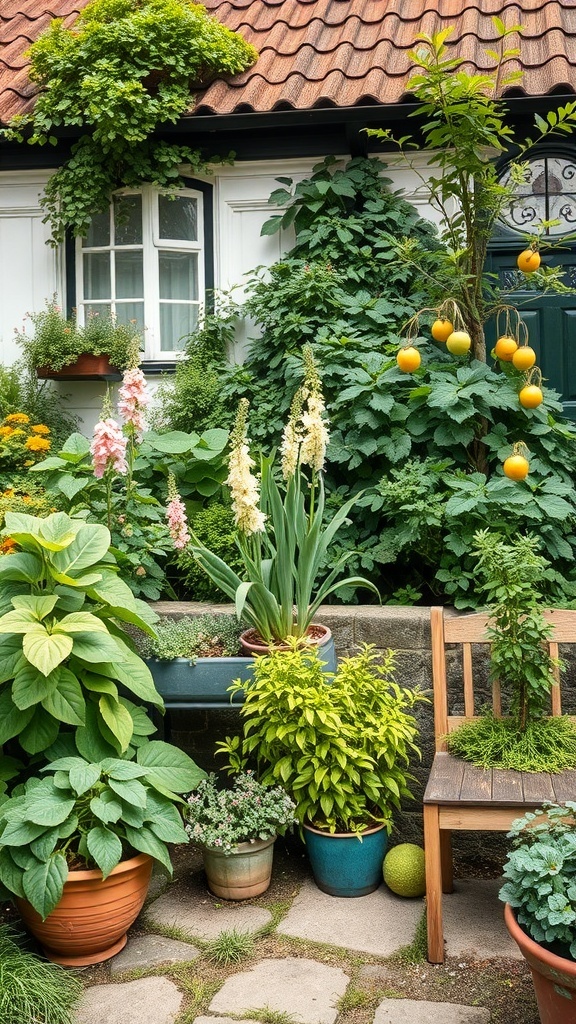
Cottage gardens are charming and inviting, and they can be even more delightful when you include edible plants. Imagine walking through a garden filled with vibrant flowers and the fresh scent of herbs. This combination not only beautifies your space but also provides fresh ingredients for your meals.
In the image, you can see a lovely mix of greenery and colorful plants. The tall flowers add height and interest, while the various pots showcase herbs and small vegetables. This setup encourages a casual stroll, allowing you to pick a few herbs or even some fruit as you enjoy the garden.
Consider adding plants like tomatoes, peppers, or even strawberries. These can thrive alongside your decorative plants, creating a lush and productive space. Herbs like basil, mint, and rosemary are perfect for pots, making them easy to access while cooking.
When planning your garden, think about the layout. Grouping edible plants with ornamental ones creates a harmonious look. The key is to blend colors and textures, ensuring that your garden is both beautiful and functional. With a little creativity, you can turn your cottage garden into a feast for the eyes and the palate!
Seasonal Color Schemes for Year-Round Appeal
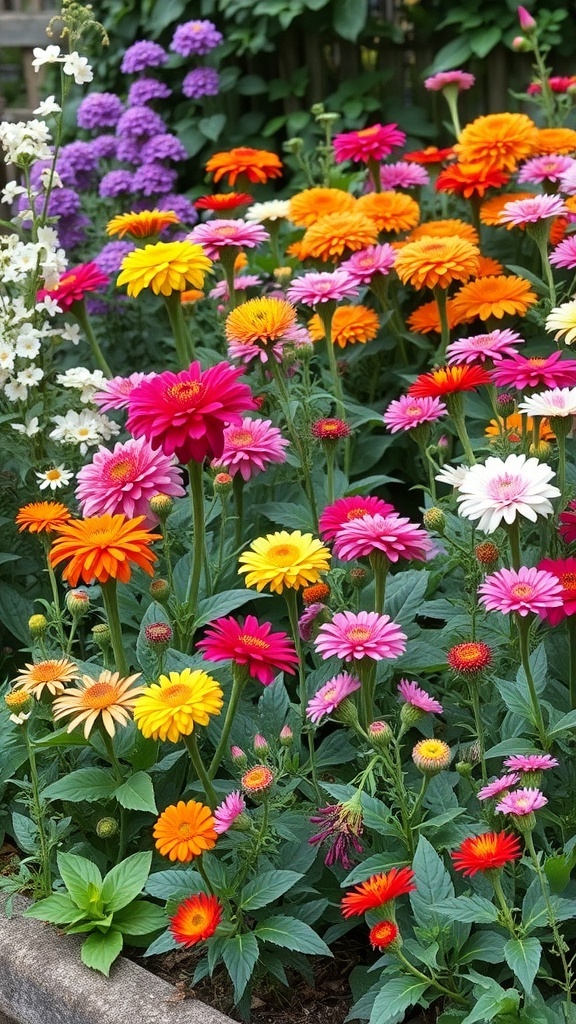
A cottage garden thrives on color, and the image captures a stunning array of blooms. Bright pinks, oranges, yellows, and purples create a lively scene that invites joy and warmth. These vibrant flowers not only catch the eye but also set the mood for each season.
In spring, you can start with cheerful daffodils and tulips, adding layers of color as the weather warms. As summer approaches, the zinnias and gerbera daisies take center stage, just like in the image. Their bold colors create a lively atmosphere, perfect for outdoor gatherings.
As the seasons change, consider incorporating autumn hues with marigolds and asters. These flowers will bring a cozy feel as the days grow shorter. Even in winter, evergreen foliage can provide structure, while winter-blooming plants like hellebores add unexpected beauty.
Mixing these seasonal blooms keeps your garden looking fresh and inviting throughout the year. The key is to plan ahead and choose flowers that complement each other, ensuring your cottage garden remains a colorful retreat no matter the season.
Utilizing Vertical Space with Climbing Plants
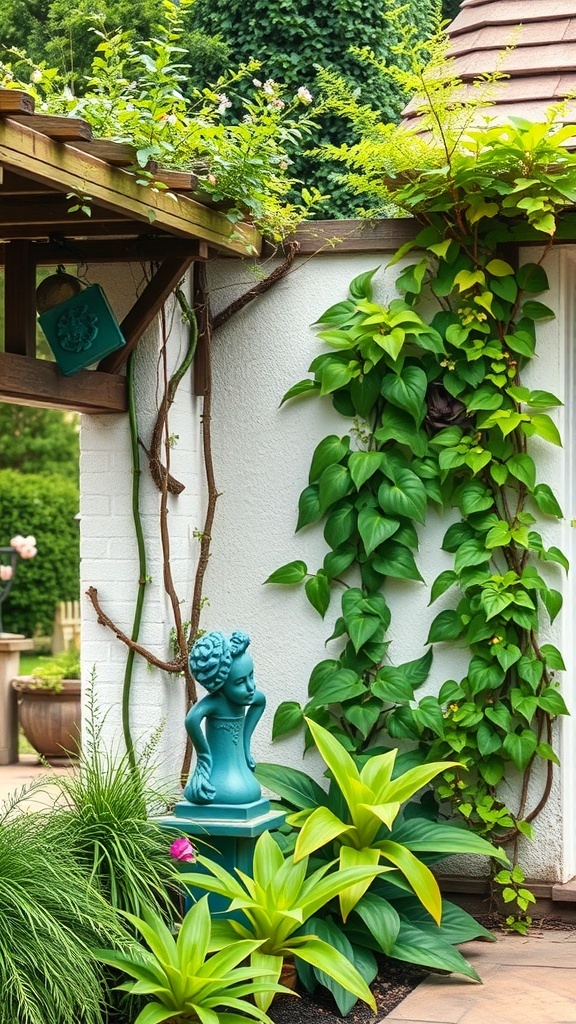
Climbing plants are a fantastic way to make the most of vertical space in your cottage garden. They can transform plain walls and fences into lush, green backdrops. In the image, you can see vibrant green vines climbing up a white wall, creating a striking contrast. This not only adds visual interest but also helps to soften hard surfaces.
The use of climbing plants can also provide privacy and shade. They can be trained to grow over trellises or arbors, making cozy spots in your garden. The statue in the image adds a charming touch, blending nature with art. This combination creates a welcoming atmosphere that invites you to relax.
When choosing climbing plants, consider varieties that are suited to your climate and garden conditions. Some popular options include clematis, wisteria, and ivy. These plants can thrive with minimal care while adding beauty to your space. Incorporating climbing plants is a simple way to enhance your cottage garden design.
Incorporating Rustic Garden Structures
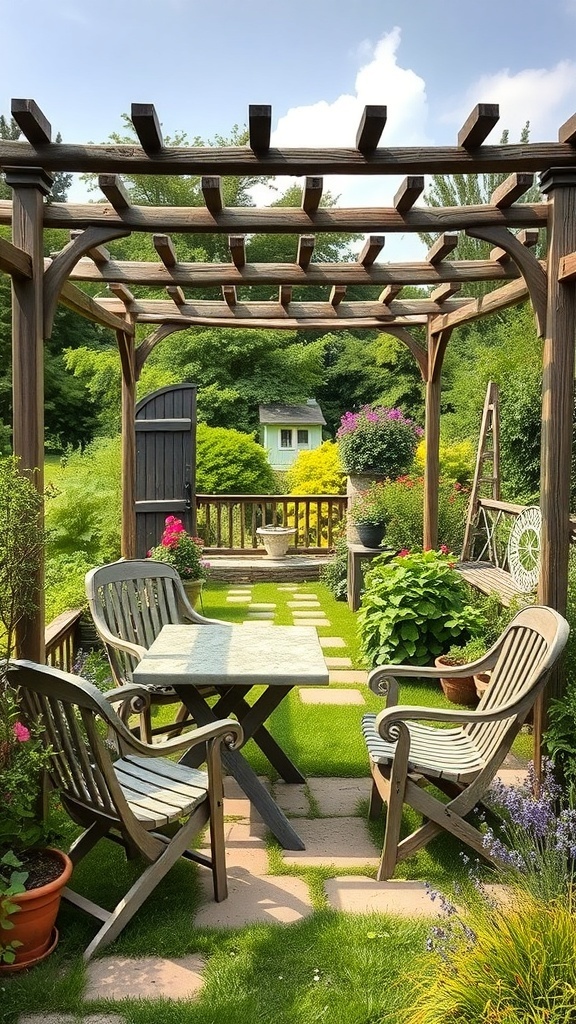
Rustic garden structures can bring charm and character to any cottage garden. The image shows a lovely pergola, which serves as a perfect focal point. It offers a cozy spot to relax while surrounded by nature.
The wooden chairs and table invite you to sit down with a book or enjoy a cup of tea. The stone pathway leads the eye through the garden, creating a sense of flow. This design encourages exploration and appreciation of the plants around.
Colorful flowers in pots add vibrancy and warmth. They complement the greenery beautifully, enhancing the overall aesthetic. A rustic gate in the background hints at more to discover beyond the garden.
Incorporating these structures not only adds functionality but also creates a welcoming atmosphere. Whether it’s a pergola, trellis, or garden bench, each piece contributes to the garden’s story.
Creating Wildlife-Friendly Spaces
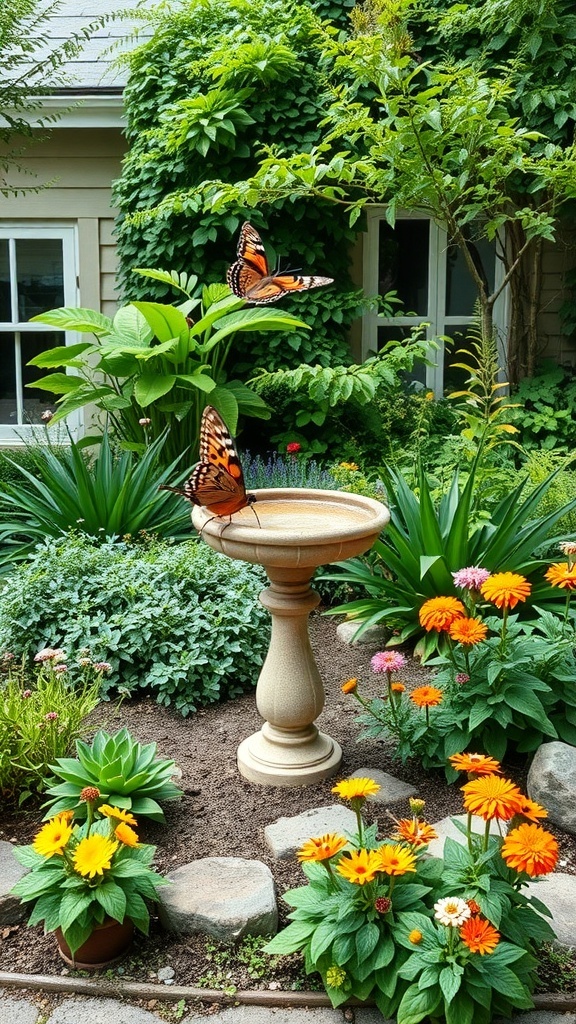
Creating a wildlife-friendly garden is a wonderful way to connect with nature. The image shows a charming garden with a birdbath, surrounded by vibrant flowers and lush greenery. Butterflies flutter around, adding life and color to the scene.
Incorporating elements like a birdbath attracts various birds and insects. This simple addition provides a water source for wildlife, making your garden a lively spot. The colorful flowers not only brighten the space but also serve as food for pollinators like butterflies.
Choosing native plants is key. They require less maintenance and offer essential habitats for local wildlife. By planting a mix of flowers, shrubs, and trees, you create layers of habitat that support different species.
Consider adding features like logs or stones for shelter. These elements provide safe spaces for small creatures. A diverse garden encourages a variety of wildlife, making it a delightful place to spend time.
Designing with Sustainable Practices
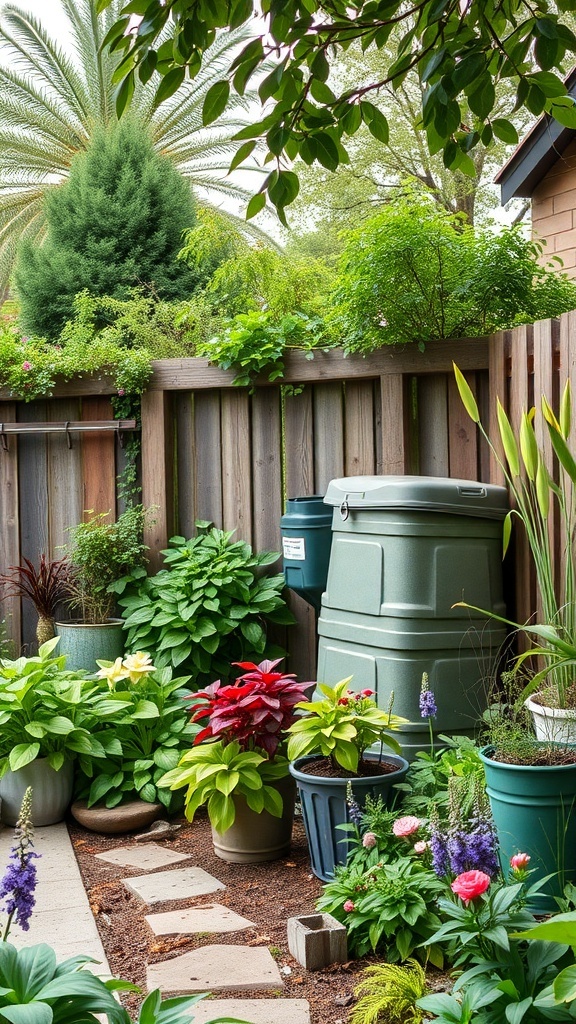
Creating a cottage garden is a lovely way to embrace nature while being kind to the environment. The image shows a vibrant garden filled with various plants, showcasing how you can design a space that thrives sustainably. The use of pots and planters adds a charming touch and allows for easy management of plants.
Incorporating native plants is a great way to start. They require less water and are more resilient to local pests. The colorful foliage and flowers in the image highlight how beautiful these plants can be. Mixing different sizes and shapes of pots creates visual interest while promoting biodiversity.
Another key aspect is composting. The green compost bin in the image is a perfect example of how to recycle kitchen scraps and yard waste. This practice enriches the soil and reduces waste. It’s a win-win for your garden and the planet!
Lastly, consider using rain barrels to collect water. This not only conserves water but also provides your plants with natural hydration. Overall, a cottage garden can be both beautiful and sustainable, making it a delightful addition to any home.
